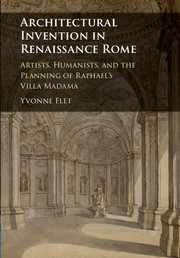 Architectural Invention in Renaissance Rome
Architectural Invention in Renaissance Rome Book contents
- Frontmatter
- Dedication
- Contents
- List of Plates
- List of Figures
- Preface and Acknowledgments
- Note on Translations and Abbreviations
- Introduction: The Nature of Invention, in Word and Image
- 1 Reviving the Corpse
- 2 Writing Architecture
- 3 Sperulo's Vision
- 4 Encomia of the Unbuilt
- 5 Metastructures of Word and Image
- 6 Dynamic Design
- Conclusion: Building With Mortar and Verse
- APPENDIX I Francesco Sperulo, Villa Iulia Medica versibus fabricata/ The Villa Giulia Medicea Constructed in Verse: critical edition and translation by Nicoletta Marcelli and gloss by the Author
- APPENDIX II Francesco Sperulo, Villa Iulia Medica versibus fabricata: Analysis of the presentation manuscript
- APPENDIX III Francesco Sperulo, Ad Leonem X de sua clementia elegia xviiii
- Notes
- Bibliography
- Index
Preface and Acknowledgments
Published online by Cambridge University Press: 06 January 2018
- Frontmatter
- Dedication
- Contents
- List of Plates
- List of Figures
- Preface and Acknowledgments
- Note on Translations and Abbreviations
- Introduction: The Nature of Invention, in Word and Image
- 1 Reviving the Corpse
- 2 Writing Architecture
- 3 Sperulo's Vision
- 4 Encomia of the Unbuilt
- 5 Metastructures of Word and Image
- 6 Dynamic Design
- Conclusion: Building With Mortar and Verse
- APPENDIX I Francesco Sperulo, Villa Iulia Medica versibus fabricata/ The Villa Giulia Medicea Constructed in Verse: critical edition and translation by Nicoletta Marcelli and gloss by the Author
- APPENDIX II Francesco Sperulo, Villa Iulia Medica versibus fabricata: Analysis of the presentation manuscript
- APPENDIX III Francesco Sperulo, Ad Leonem X de sua clementia elegia xviiii
- Notes
- Bibliography
- Index
Summary
This book is not the one I set out to write. After finishing a dissertation about Villa Madama, Raphael's paradigmatic Roman villa for the Medici popes, and in the course of writing a monograph, my analysis of proleptic poetry about the villa began expanding and leading me in new directions. The resulting book is only partly about the villa itself; it became a prismatic topic reflecting several aspects of Italian Renaissance culture, especially the nature of invention in architectural design, and shifting tensions in the relation of word and image. The resulting book focuses on the collaboration of architects and humanists in the design of architecture. The coming-into-being of Villa Madama is the case study that anchors the book, although its implications are broader. Thus, this multidisciplinary work operates at the intersection of several topics: Raphael as architect, villa culture, literary studies, and the history of humanism.
Although even students of the Renaissance might question the need for another book on Raphael, in fact studies of Raphael as architect have been quiet in the last thirty years, following the intense focus on the subject during the series of international exhibitions, conferences, and publications held in 1983–4 celebrating the quincentenary of Raphael's birth. The centerpiece of these projects was the Raffaello architetto exhibition in Rome's Palazzo dei Conservatori, the eponymous catalogue of which remains the only modern monograph on Raphael's architecture. Caroline Elam assessed the state of Raphael scholarship following those events, noting:
The pioneering days of Raphael studies are perhaps nearly over … What came out of the conference was that while the biographical facts and the limits of the oeuvre are more securely established, the need for more subtle modes of historical interpretation remains. While attempts to distinguish hands in the later works may be sterile, one looks forward to a more convincing model for characterizing the collaboration between Raphael and his assistants. Equally, perhaps our notions of the evolution of a project can be refined to include concurrent or overlapping ideas, and to entertain a creative interchange between artist and patron.
Her call has certainly been answered in subsequent studies, as detailed herein. This book extends the roster of collaborators to include humanists, and their role in the design of architecture. It thereby opens a new view of architectural invention, in word and image, in Renaissance Rome.
- Type
- Chapter
- Information
- Architectural Invention in Renaissance RomeArtists, Humanists, and the Planning of Raphael's Villa Madama, pp. xix - xxivPublisher: Cambridge University PressPrint publication year: 2018


